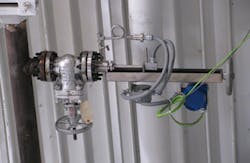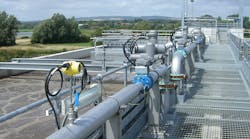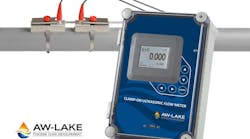The "traditionals" are the market mainstays, have been around longer and have a large installed base. Examples include differential-pressure (DP), positive-displacement and turbine flowmeters, although open-channel and variable-area meters also fall into this category.
Introduced after 1950, the new-technology meters remain the focus of suppliers’ product-development efforts. They include Coriolis and ultrasonic, along with magnetic, vortex and thermal flowmeters.
As for those emergent, in the past 30 years, sonar, optical and multiphase type flowmeters have arrived on the scene.
Sonar meters use sound waves to detect natural disturbances in the flow in the form of turbulent eddies. They detect the presence of an eddy by finding the flow-stream low-pressure areas that are associated with such eddies. In like manner, vortex meters find low-pressure areas to detect the presence of vortices. Sonar meters process data concerning turbulent eddies to determine how fast they travel. They then compute flow velocity from this information. Sonar flowmeters are clamp-on style meters.
(An eddy is a current at variance with the main current in a stream of liquid or gas, especially in a circular motion. A vortex is a region within a fluid where the flow is mostly a spinning motion around an imaginary axis.)
Optical and multi-phase
Optical flowmeters use laser beams to measure gas flow by sensing the velocity of the microscopic particles part of natural gas or industrial gases flowing through a pipe. They do so by focusing two laser spots in the gas stream. The optical flowmeter computes the gas flow velocity based on the sensor’s optical signals. One advantage is wide rangeability — they can effectively measure flow at a variety of rates. Another advantage is that measurement capability is not dependent on gas composition. Optical flowmeters are insertion-style meters.
Close study of multiphase flowmeters began in the early 1980s in Norway in response to gradually reducing North Sea oil fields. Multiphase flowmeters measure the amounts of oil, gas and water coming out of a well. In the past, fluids had to be first physically separated and then measured.
Given the extremely complex ownership and operating arrangements associated with oil and gas exploration and production, the sooner production is measured after emerging from a well, the happier everyone is. Moreover, multiphase meters improved capabilities to measure and analyze the changing make up of petroleum coming out of the North Sea oil fields.
Much of the development work came out of Norway’s Christian Michelsen Institute, and it resulted in the creation of Fluenta AS, Haugesund, Norway. (Subsea oil & gas specialist Roxar ASA acquired Fluenta, specializing in multiphase meters, flare gas meters and sand monitoring in 2001. Roxar was acquired by Emerson, St. Louis, Missouri, in 2009.)
Multiphase flowmeters make multiple measurements, including temperature, pressure and differential pressure. A nuclear source, usually gamma rays, helps determine fluid properties. Some multiphase meters use a high-energy source of gamma rays, others low. Some suppliers make use of both sources in combination.
Many multiphase flowmeters incorporate a Venturi tube. Bernoulli’s theorem computes flow rate, as with other DP flow devices. A combination of temperature, pressure, and DP measures determine density. Differentiating the percents of gas, water and oil that make up the fluid is based on gamma ray technology. Given known percentages of each fluid type and the DP flow rates, the individual oil, gas and water flow rates are easily determined.
Matrixing matters
A flowmeter is classified as new-technology, traditional or emerging-technology based on when it was introduced, its performance and other factors. But another way to look at flowmeters is based on the distinction between those that use multiple technologies to make a measurement and those that need only one. These can be considered "multi-tech" meters.
One clear example of multi-tech is the multivariable flowmeter. Multivariable flowmeters use volumetric flow plus pressure and/or temperature to compute mass flow.
In somewhat the same vein, in further classifying flowmeters, they can be matrixed for capabilities that work with more than one flowmeter type. These can be considered "crossover" meters. Examples of crossover meters are insertion, inline or clamp-on installation, battery operation and wireless communications.
Battery-operated and wireless flowmeters become more important as flow-measurement needs in hard-to-reach areas increase or where electricity is not available. Magnetic, ultrasonic and vortex meters can be battery-operated. Examples of wireless flowmeters include DP, magnetic and ultrasonic.
Since its introduction into process control less than a decade ago, wireless is providing tremendous benefits in the inexpensive installation of sensors and transmitters in industrial environments.
Flowmeters with insertion designs include magnetic, ultrasonic, vortex, thermal, differential pressure and turbine. Clamp-on flowmeters include ultrasonic and sonar.
Insertion flowmeters are of special interest because of on-going development aimed at more accurate, reliable inline flowmeters. Another reason is the oil and gas field applications already mentioned. Inline flowmeters typically are more accurate than insertion and clamp-on meters. For example, multi-path meters, which are the most accurate ultrasonic flowmeters, are inline.
Push to insert
Besides inline flowmeter development, there is a push to develop more sophisticated insertion flowmeters. With the largest pipe diameters, an inline flowmeter can’t be cost-effective. This especially applies to large magnetic flowmeters in the water and wastewater industry. Here, large pipes can range anywhere from 20 inches in diameter to greater than 100 inches. Insertion flowmeters are an ideal solution, especially since the accuracy of custody transfer is not generally required.
Another good insertion flowmeter application is stack-flow and flare-gas measurement. Stack-flow measurement can be required to track emissions. Exhaust-pipe stacks and ducts are often very large and inline flowmeters not practical. But insertion thermal, ultrasonic and averaging Pitot tubes are all used for this purpose. Because all are effective in making this measurement, choosing a technology depends on price, vendor preference, familiarity with the technology and other factors.
Though not as accurate as some inline meters, insertion flowmeters are worth considering for large pipe applications, as well as when accuracy requirements are medium to low and when cutting through the pipe is undesirable. Insertion meters generally require drilling a hole in the pipe, but their cost is usually less than the corresponding inline meters because they do not have a meter body.
Categorizing by meter installation type makes it easier to make valid comparisons.
Those looking at stack-gas measurement can compare insertion ultrasonic, thermal, and averaging Pitot tube technologies. Or someone who wants to measure water flow in an 84-inch pipe can compare insertion magnetic, ultrasonic and turbine technologies. This approach not only makes sense, it can also be the road to finding the best measurement technology for a particular application.
Final words
With crude oil prices continuing in the $100 per barrel range, petroleum production continues to extend into the very toughest global environments. At the same time, natural gas is viewed as a cleaner substitute for oil, and as a long-term bridge to renewables. So there has been a corresponding push for exploration and production of natural gas. Thus, the nature of supply and demand, market characteristics and environmental concerns all conspire to put a premium on accurate measurement.
Jesse Yoder, PhD, is president of Flow Research, Inc. in Wakefield, Massachusetts (www.flowresearch.com), a company he founded in 1998. He has 27 years of experience as an analyst and writer in process control. He has authored over 160 market research studies in industrial automation and process control, and has written more than 220 published journal articles on instrumentation topics. Study topics include Coriolis, magnetic, ultrasonic, vortex, thermal, differential pressure, positive displacement and turbine flowmeters. He recently completed a series of six studies on oil flow measurement comprising over 2800 pages, and is currently working on the second edition of a parallel series of studies on gas flow measurement. Dr. Yoder is a regular speaker at flowmeter conferences, both in the United States and abroad.



